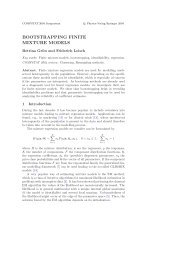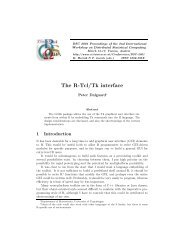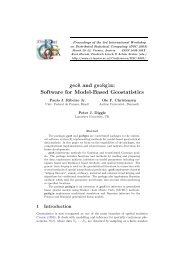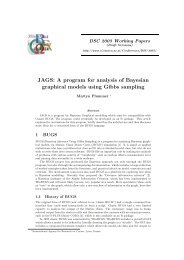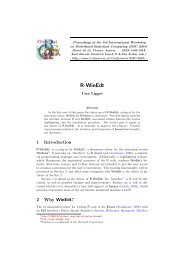Embedding R in Windows applications, and executing R remotely
Embedding R in Windows applications, and executing R remotely
Embedding R in Windows applications, and executing R remotely
You also want an ePaper? Increase the reach of your titles
YUMPU automatically turns print PDFs into web optimized ePapers that Google loves.
The third reason is quality control. The CRAN team already goes to great length, <strong>in</strong>clud<strong>in</strong>g un-supervised<br />
nightly builds, to ensure the <strong>in</strong>dividual quality <strong>and</strong> coherence of an R package. <strong>Embedd<strong>in</strong>g</strong> a b<strong>in</strong>ary R package<br />
<strong>in</strong> the Debian package management system provides additional control over dependencies between required<br />
components or libraries, as well as access to a fully automated system of ‘build daemons’ which can recompile<br />
a source package for up to ten other architectures – which provides a good portability <strong>and</strong> quality control<br />
test.<br />
The fourth reason is scalability. More <strong>and</strong> more users are us<strong>in</strong>g several mach<strong>in</strong>es, or may need to share<br />
work with co-workers. Be<strong>in</strong>g able to create, distribute <strong>and</strong> <strong>in</strong>stall identical b<strong>in</strong>ary packages makes it easier<br />
to keep mach<strong>in</strong>es synchronised <strong>in</strong> order to provide similar environments.<br />
The fifth reason plays on Debian’s strength as a common platform for other ’derived’ systems. Examples<br />
for Debian derivatives <strong>in</strong>clude entire distributions such as L<strong>in</strong>dows or Libranet, as well as Knoppix <strong>and</strong> its<br />
own derivatives such as Quantian. Provid<strong>in</strong>g Debian packages of R packages allows others to use these <strong>in</strong><br />
entirely new environments.<br />
4 Debianis<strong>in</strong>g CRAN: How ?<br />
As noted above, R itself has been a part of Debian s<strong>in</strong>ce 1997. B<strong>in</strong>ary Debian packages of contributed R<br />
libraries have been created s<strong>in</strong>ce March 2003, start<strong>in</strong>g with RODBC <strong>and</strong> tseries. Currrently, several Debian<br />
ma<strong>in</strong>ta<strong>in</strong>ers work<strong>in</strong>g more-or-less <strong>in</strong>dividually provide a variety of CRAN packages totall<strong>in</strong>g about thirty-five<br />
packages (see the Appendix for a list). A proposed Debian R Policy (Bates <strong>and</strong> Eddelbuettel, 2003) is aid<strong>in</strong>g<br />
<strong>in</strong> keep<strong>in</strong>g these package <strong>in</strong> a coherent <strong>and</strong> homogeneous form.<br />
Also, most W<strong>in</strong>dows users rely on the R packages (currently ma<strong>in</strong>ta<strong>in</strong>ed by Uwe Ligges) for their operat<strong>in</strong>g<br />
system distributed at CRAN. SuSE L<strong>in</strong>ux users can grab their packages from CRAN. The <strong>in</strong>creas<strong>in</strong>g work<br />
load with packag<strong>in</strong>g especially these SuSE L<strong>in</strong>ux packages lead one of us (A. Gebhardt) some years ago to<br />
switch<strong>in</strong>g to a more automated process. This resulted <strong>in</strong> a Perl script 1 which does the whole job of build<strong>in</strong>g<br />
the RPM files. This script is still <strong>in</strong> use by Detlef Steuer who is currently <strong>in</strong> charge of be<strong>in</strong>g the package<br />
builder for contributed package for the SuSE L<strong>in</strong>ux distribution.<br />
More recently, this script has been modified 2 to perform a similar task for the Debian community. It<br />
performs the follow<strong>in</strong>g steps:<br />
1. Retrieve an up-to-date package list<br />
(ftp://cran.r-project.org/pub/R/contrib/ma<strong>in</strong>/PACKAGES).<br />
2. Retrieve the library description files<br />
(ftp://cran.r-project.org/pub/R/contrib/ma<strong>in</strong>/Descriptions/*.DESCRIPTION).<br />
3. Parse these description files us<strong>in</strong>g the R::Dcf Perl module.<br />
4. Determ<strong>in</strong>e a package dependency graph based on the ”Depends:” statements found <strong>in</strong> the description<br />
files.<br />
5. Generate a Debian package build structure (accord<strong>in</strong>g to the Debian R package policy).<br />
6. F<strong>in</strong>ally build <strong>and</strong> <strong>in</strong>stall the Debian packages <strong>in</strong> correct order (bottom to top <strong>in</strong> the dependency graph).<br />
This process relies much on the format of the DESCRIPTION files of the <strong>in</strong>dividual libraries. It can<br />
cope automatically with <strong>in</strong>ter-library dependencies. However, it can not yet deal with dependencies on<br />
non-R software, e.g. external programs like xgobi or GRASS. In these cases, some help is required from a<br />
hard-coded dependency list that can be kept <strong>in</strong> a small ‘knowledge base’, either as simple flat-file or a small<br />
RDBMS. The build process <strong>in</strong>volves an extra run of ”R CMD check” <strong>and</strong> <strong>in</strong>sures that way that only correctly<br />
work<strong>in</strong>g packages will be distributed.<br />
1 Available at http://cran.r-project.org/b<strong>in</strong>/l<strong>in</strong>ux/suse/build-R-contrib-rpms.pl.<br />
2 The new version is available at http://www.math.uni-klu.ac.at/~agebhard/build-R-contrib-debs.pl.<br />
3




